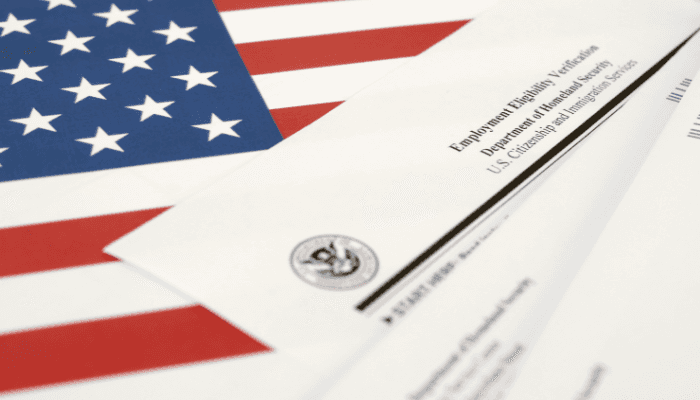Recently, U.S. Citizenship and Immigration Services (USCIS) announced that Form I-9 is getting updated. When onboarding new hires, employers must use Form I-9 to verify an employee’s identity and that they have proper authorization to be employed in the United States.
If you plan to hire employees in 2023, the I-9 update may affect you. Here’s what you need to know about the new I-9 rules and how to proceed with vetting new employees.
What Does the I-9 Update Mean for Employers?
The effective date for the updated version of Form I-9 is August 1, 2023. The form should say “Rev. 8/01/23” while the previous version says “Rev. 10/21/19”. However, to allow time for employers to prepare and adjust, the older version of Form I-9 may still be used until October 31, 2023. If you use the old version of Form I-9 for new hires after this date, USCIS will assess a penalty.
The new I-9 form has been substantially shortened and streamlined. This major update now reflects the economic and technological reality of remote jobs, where a hiring manager or payroll service may be located in an entirely different state than the employee and cannot easily verify a physical document in person.
Additionally, USCIS has made the following policies changes of note to expedite the onboarding process for employers and employees alike:
Remote Document Examination
The US Department of Homeland Security (DHS) issued a final ruling regarding the creation of new framework governing alternative document examination procedures for employers. With the rise of remote jobs and digitized documents in recent years, this change is long overdue.
Subsequently, Form I-9 has been updated to indicate whether a new employee’s documents were verified physically or remotely under DHS-approved alternative examination guidelines.
E-Verify Clarification
Employers who use E-Verify and are in good standing with DHS can continue to utilize it for employee verification after August 1, 2023. E-Verify employers must conduct live video interviews with remote employees, retain copies of documents submitted during I-9 verification, and create an E-Verify case for each new employee.
How to Complete the Updated I-9 Form
Section 1
Collects identifying information about the employee. The employee must attest whether they are authorized to work in the United States by way of US citizenship or national, lawful permanent residence, or a noncitizen with the correct authorization. This section is completed at the time of hiring.
Section 2
Within three days of being hired, the employee needs to prove their identity and authorization for employment. This entails the employee presenting original documents for the employer to review that verify their identity and work authorization, such as a passport and Social Security card.
Supplement A
If a new hire has a paid preparer or translator assist them with completing Section A, Supplement A should be completed as well. Otherwise, it can be omitted.
Supplement B
Employers should complete Supplement B if an employee is rehired or the situation requires re-verification of an employee’s identity. If an employee’s name changes, Supplement B may be used to record it. Supplement B should be completed before the employee’s current work authorization expires.
What Should Employers Do with Form I-9 After Completion?
Employers must keep an employee’s completed I-9 on file for the duration of their employment plus the latter of three years after their hire date or one year after their termination date.
Government agencies like DHS, federal and state Departments of Labor, and the Department of Justice may request an inspection of all employees’ I-9 forms. Failure to properly retain and furnish these forms at all, or submitting incomplete I-9 forms, may result in civil or even criminal penalties.
What Has Changed on Form I-9 Since the 2023 Update?
Form I-9 has shrunk to a more simplified format that now accounts for the realities of remote work. The following changes have been made:
- Sections 1 and 2 were reduced to a single-sided sheet since multiple fields were merged
- Supplement A is now a standalone supplement where employers may attach additional sheets if needed
- Supplement B is now standalone from Section 3, Reverification and Rehire; employers may attach additional sheets if needed
- Section 1 has reworded “alien authorized to work” with “noncitizen authorized to work” and clarified the difference between a noncitizen national and a noncitizen authorized to work
- Form I-9 is now fillable on mobile devices and tablets
- Form I-9 can now be downloaded more easily after various features were removed
- No longer required to enter N/A in certain fields
- Nondiscrimination notice at the top of the form updated
- Revised the lists of acceptable documents, which now includes guidance and links on automatic extensions
- Added a checkbox for certain eligible employers if a DHS-authorized alternative procedure was used instead of a physical document examination
Whether you’re growing your business or seeking new talent when an employee vacates a role, the last thing you want to worry about is bottlenecks in the hiring process. As payroll experts, we stay up to date on mandated authorization forms and processes so that you can focus on managing and expanding operations. Contact ASAP Payroll Solutions today so that we can simplify your employee onboarding.





